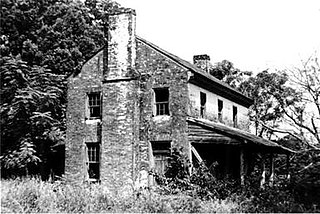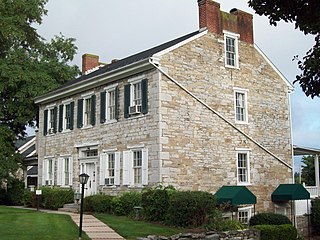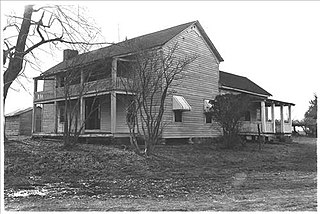
Bryan County is a county located in the U.S. state of Georgia. As of the 2020 census, the population was 44,738. The county seat is Pembroke.

Georgetown is the third oldest city in the U.S. state of South Carolina and the county seat of Georgetown County, in the Lowcountry. As of the 2010 census it had a population of 9,163. Located on Winyah Bay at the confluence of the Black, Great Pee Dee, Waccamaw, and Sampit rivers, Georgetown is the second largest seaport in South Carolina, handling over 960,000 tons of materials a year, while Charleston is the largest.

Fort McAllister State Park is a 1,725 acres (698 ha) Georgia state park located near Keller and Richmond Hill in south Bryan County, Georgia and on the south bank of the Ogeechee River. It is roughly ten miles south of Savannah. The park is home to Fort McAllister, the best-preserved earthwork fortification of the Confederacy. Though the earthworks were attacked unsuccessfully seven times by Union soldiers, it did not fall until it was taken by General Sherman in 1864 during his March to the Sea. The park, located on the coast, is nestled among giant live oaks and a large salt marsh. In addition, the park contains a museum specializing in Civil War artifacts. The fort was added to the National Register of Historic Places in 1970.

Fort McAllister was a Confederate earthen-work fort used to defend Savannah, Georgia during the American Civil War. It was the southernmost of the forts defending Savannah and was involved in the most battles. It was located on the Ogeechee River in Bryan County. It is listed on the National Register of Historic Places (#70000197). Fort McAllister was one of three forts protecting Savannah, the others being Fort Pulaski and Fort James Jackson standing in Confederate defiance of the Union naval blockade. The southeast coast of the United States was the place where both combatants tested the latest in naval artillery and coastal defenses. Fort McAllister was the key to unlocking the defenses around Savannah, one of the most important Confederate ports on the Atlantic Ocean.

Keller is a small unincorporated community located in southern Bryan County, Georgia, United States, east of Richmond Hill. Its boundaries are ill-defined, but the community could be said to be centered on the intersection of S.R. 144 and Belfast-Keller Road. Currently the area, like most of South Bryan, is an unincorporated community of extensive residential development with a number of planned neighborhoods. However, Keller also has a significant historical aspect. It is near Fort McAllister Historic Park, an earthen Civil War installation captured by General William Sherman on his March to the Sea. Bryan Neck Presbyterian Church, established in 1839 and rebuilt in 1885, is listed on the National Register of Historic Places, and is located on Belfast-Keller Road about a mile from the S.R. 144 intersection. A number of antebellum plantation houses or sites exist along the marshes and waterfront areas of extreme south Bryan County, though none are in public hands or are preserved as historic sites.

Magnolia Plantation and Gardens is a historic house with gardens located on the Ashley River at 3550 Ashley River Road west of Ashley, Charleston County, South Carolina. It is one of the oldest plantations in the South, and listed on the National Register of Historic Places. Magnolia Plantation is located near Charleston and directly across the Ashley River from North Charleston. The house and gardens are open daily; an admission fee is charged.

Archibald McAllister was a Democratic member of the U.S. House of Representatives from Pennsylvania.

The William S. Simmons Plantation, also known as the Wesley House, is a Greek Revival brick home located in Cave Spring, Georgia, United States, North America. The home was built in the 1840s, prior to the American Civil War, and was listed on the National Register of Historic Places in 1980.

Hampton Plantation, also known as Hampton Plantation House and Hampton Plantation State Historic Site, is a historic plantation, now a state historic site, north of McClellanville, South Carolina. The plantation was established in 1735, and its main house exhibits one of the earliest known examples in the United States of a temple front in domestic architecture. It is also one of the state's finest examples of a wood frame Georgian plantation house. It was declared a National Historic Landmark in 1970.

The McGehee–Stringfellow House, also known as Oak Grove, was a historic plantation house near Greensboro, Alabama, United States. It was added to the National Register of Historic Places on September 17, 1980, due to its architectural significance. It was accidentally destroyed in the 1980s during an attempt to move it to another location.

Farmer's Delight was built in Loudoun County, Virginia in 1791 by Colonel Joseph Flavius Lane. The Federal style brick plantation house incorporates elements of Georgian architecture. The house is now closely associated with American oilman and diplomat George C. McGhee, who owned the property after 1948. The house is maintained by the McGhee Foundation and is listed on the National Register of Historic Places.

The McAllister-Beaver House is an historic, American home that is located in Bellefonte, Centre County, Pennsylvania.

Wild Heron is a historic plantation house approximately 15 miles (24 km) south of Savannah, Georgia. It is one of the oldest domestic structures in Georgia and is a relatively intact example of a typical architectural genre which flourished in coastal Georgia and South Carolina in the eighteenth century. Adding to its significance is its association with Francis Henry Harris (1710–1771) and his son, Col. Francis Henry Harris (1740–1782), prominent figures of the Colonial and Revolutionary eras in Georgia, and the operation through two hundred years as a working rice plantation, owned for much of that time by descendants of the same family.

Grove Plantation is a plantation house in Adams Run, South Carolina.

Wicklow Hall is a historic Plantation complexes in the Southern United States located near Georgetown, Georgetown County, South Carolina. The complex includes the house and several dependencies. Wicklow Hall is a two-story, Greek Revival style clapboard structure on a low brick foundation. The main portion of the structure was probably built between about 1831 and 1840 and enlarged by additions after 1912. Also on the property are a kitchen, corn crib, carriage house, a small house, stable, privy, and a schoolhouse. Wicklow was a major rice plantation during the mid-1800s, and associated with the prominent Lowndes family of South Carolina.

Ashley Hall Plantation is a historic plantation complex located on the Ashley River near West Ashley, Charleston County, South Carolina. The plantation was established in the early 1670s by Stephen Bull. The property includes a small tabby-walled house with a 20th-century second story addition, the ruins of the Georgian plantation house (1704) which was burned in 1865 to prevent its destruction by Union forces, a monument to the second Governor William Bull, two prehistoric Indian archaeological sites, and two 18th century well sites associated with the plantation. The tabby house is considered one of the oldest standing houses in the state.

The Hofwyl-Broadfield Plantation was a plantation on the Altamaha River, in Glynn County, Georgia. Operated as a forced-labor farm using enslaved peoples until 1865, it produced rice from 1800 until 1915, when growing rice became unprofitable. Then it was primarily a dairy farm until 1942. Since 1976, the Georgia Department of Natural Resources has managed it as Hofwyl-Broadfield Plantation State Historic Site.

Lebanon Plantation is a state historic site located at 5745 Ogeechee Road in Savannah, Georgia. The site is over 500 acres (2.0 km2) consisting of a large estate granted to James Deveaux in 1756, and was named for the many cedar trees on the property. An additional 500 acres were granted to Phillip Delegal in 1758 and eventually became part of the plantation. The site was purchased by Joseph Habersham in 1802. Habersham sold it in 1804 to George W. Anderson who built the main house that was rebuilt and added on to after the American Civil War. Anderson's son, George Wayne Anderson, JR Commanded Fort McAllister in the Civil War, and after the fort fell, Lebanon became his prison and the headquarters of the Fifteenth Army Corps of the US Army.

The Bowman-Pirkle House is a historic two-story log house in Buford, Georgia.






















